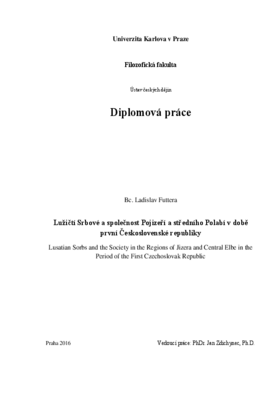Lužičtí Srbové a společnost Pojizeří a středního Polabí v době první Československé republiky
Lusatian Sorbs and the Society in the Regions of Jizera and Central Elbein the Period of the First Czechoslovak Republic
diplomová práce (OBHÁJENO)

Zobrazit/
Trvalý odkaz
http://hdl.handle.net/20.500.11956/75671Identifikátory
SIS: 154443
Kolekce
- Kvalifikační práce [22841]
Autor
Vedoucí práce
Oponent práce
Čechurová, Jana
Fakulta / součást
Filozofická fakulta
Obor
Historie - české dějiny v evropském kontextu - Učitelství českého jazyka a literatury pro střední školy
Katedra / ústav / klinika
Ústav českých dějin
Datum obhajoby
23. 5. 2016
Nakladatel
Univerzita Karlova, Filozofická fakultaJazyk
Čeština
Známka
Výborně
Klíčová slova (česky)
Českolužický spolek "Adolf Černý", Lužičtí Srbové, Pojizeří, první Československá republika, slovanská spolupráce, Sokol, Společnost přátel Lužice, spolková činnost, střední PolabíKlíčová slova (anglicky)
Czech and Lusatian club "Adolf Černý", Lusatian Sorbs, Region of Jizera, the First Czechoslovak Republic (ČSR), Slavic cooperation, Sokol organization, Society of the friends of Lusatia, clubs activities, Region of Central ElbeV letech 1931-1934 vzniklo v Pojizeří v oblasti od Semil po Mladou Boleslav a ve středním Polabí mezi Kolínem a Nymburkem osm odborů Československo-lužického spolku "Adolf Černý" (od roku 1932 Společnosti přátel Lužice), neúspěšné pokusy o ustavení odboru navíc proběhly v Českém Brodě, Kouřimi a Lysé nad Labem. Oblast se stala po Praze nejvýznamnějším centrem styků s Lužickými Srby v meziválečném Československu. Mířily sem výpravy lužickosrbských sokolů a pěvců, prázdniny zde trávily lužickosrbské děti i vysokoškoláci, v červenci 1933 po vlně čistek a zatýkání v Německu se na podporu Lužických Srbů uskutečnila manifestace na vrchu Mužský u Mnichova Hradiště. Téma práce je vzhledem k torzovitému zachování pramenů sledováno v prvé řadě na základě studia regionálního tisku, lužickosrbského tisku a časopisu českolužického spolku Českolužického věstníku, od roku 1931 Lužickosrbského věstníku. Ucelený fond se dochoval toliko v případě semilského odboru českolužického spolku (uložen ve Státním okresním archivu v Semilech). Dále je využito nevydaných pramenů převážně z fondů Lužickosrbského kulturního archivu (Serbki kulturny archiw) v Budyšíně a Státního okresního archivu v Mladé Boleslavi. Fond Oddělení pro lužickosrbské záležitosti (Wendenabteilung), uložený ve Státním pobočném archivu...
Between the years 1931-1934, both in the region of Jizera in the area between Semily and Mladá Boleslav and in the region of Central Elbe between Kolín and Nymburk, eight subsidiary unions of the Czechoslovakian-Lusatian society "Adolf Černý" were founded. On three other places, namely in Český Brod, Kouřim and Lysá nad Labem, the attempts to establish the local unions failed. Nonetheless, the area consequently became the second most significant cultural centre as well as the meeting point of the Lusatian Sorbs in the inter-war Czechoslovakia, the first one being Prague. It was regularly visited by the Lusatian Sokol gymnasts or choirs, and Lusatian-Sorbian children as well as university students spent their holidays there. It is therefore no surprise that the Mužský Hill near the city of Mnichovo Hradiště became the location of a demonstration in support of the Lusatian Sorbs which took place there in July 1933 as a reaction to a wave of persecutions in Germany. Due to the fragmentary nature of the sources, the topic of the following thesis is based primarily on the regional press, the Sorbian press and the journal Českolužický věstník, called Lužickosrbský věstník since 1931. There is only one complete archive which remained intact, namely the one of the Semily union of the Czech-Lusatian society...
